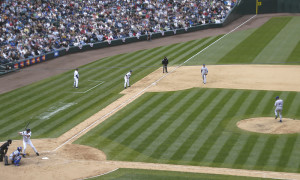My husband and I recently went to a Red Sox game. We are not the biggest of sports fans, but we like to get to a game or two each year. It was a glorious summer day – sunny sky with a temp in the mid-70’s. A  perfect Sunday afternoon for a baseball game. We all know that baseball can be slow at times with brief moments of intense action. I put my crowd dynamics lens on and observed.
perfect Sunday afternoon for a baseball game. We all know that baseball can be slow at times with brief moments of intense action. I put my crowd dynamics lens on and observed.
First there’s the “wave”. How do they start? And what does it take for them to be successful? The first one started in a section near right field, had to go through the grandstand area, and over to the “green monster”. If you don’t know Fenway Park, the green monster is a special section that probably has no more than 200 people in it. A prime spot for the wave to lose momentum. But it didn’t. It went all the way around the ballpark at least twice.
When another section started a second wave later in the game, it fizzled quickly. But my husband made sure he did it when the wave rather pathetically got to our section. He didn’t want to be the one to kill it. The takeaway – everyone must participate to make it successful.
Then there was the “dance off” between innings. The cameras focus on different fans around the park and when people see themselves on the big screen they do their best dance moves. You never know what you’ll see. Inhibitions are off for many people, especially kids. It was a young middle school age boy who won – he had the moves and the fans loved it. The takeaway – be less inhibited and you may go further.
And then there is the rhythmic clapping that starts and grows in intensity. It’s either to encourage the home team at a critical moment or to make the other team nervous. Think about the basketball games when the fans behind the basket wave all kinds of colorful things to distract the player making free throws. In baseball, when the count is three balls and two strikes, that clapping can lead to strike three. When done for the home team, it can lead to a homerun. Or so we think as fans, so we do it.
The second game for us this season was a night game. It was a real pitchers’ duel. Not a lot of action. Until the bottom of the 9th. The Red Sox were down by one, the bases were loaded, and there were two outs. Everyone was on their feet. The noise level was high. All eyes were on the pitcher and hitter. The count was 3 and 2. We were hopeful. But he struck out – game over.
Have you ever thought of trying to do your work with that kind of crowd pressure and noise? All eyes are on you and only you. Professional athletes are trained to ignore it and perform at their best. The takeaway – to deliver under pressure you need to draw on your inner strength, your calming self-talk, your best skills, and your years of experience. You just might hit your home run!
How do you handle your “bottom of the 9th” situations?

Jennifer Dennard on said:
Great post! Reminds me of the pressure I felt during tennis playoffs last spring. My partner and I lost the first set – but won the last two! Our team ended up winning the city championship that day and I know it almost had more to do with our ability to stay composed during high-pressure points and games than it did with our physical abilities. Tennis is definitely a mental game – much like our jobs can sometimes be. Now if I can just figure out how to get our “fans” to do the wave during the fall season …
Sue Schade on said:
Jennifer, great tennis story! Yes, our jobs can be mental games as well.
Chris Greene Hutchings on said:
Well put, Sue!
We all have those “bottom of the ninth” moments. My strategy is to ignore the onlookers and keep an image of the ideal end state in mind
Sue Schade on said:
Chris, great strategy!
Kirk Allan Mahlen on said:
In other words, when the pressure is on, what does one do to increase chances for success vs. failure given controllable and uncontrollable variables and the relative uniqueness of every game or situation? Reflecting back, many thoughts and words come to mind: Training, Preparation, Experience, Confidence, Integrity, Reality, Focus, Concentration, Trust, Talent, Instinct, Perseverance, Dedication, Attitude, Engagement, Effort, Intensity, … And the list could go on and on. The question seems to be at least partly about positive and refined personality traits and characteristics honed over time in addition to team dynamics. While I have had the experience of hitting home runs and striking out, catching and missing pop flys, I have also been known to simply punt.
Sue Schade on said:
Kirk, very well said! Takes all of these as you say. And then sometimes we even have to punt!
Jay Roberts on said:
Sue, just a quick note to say hi. I don’t get to read all your posts but so impressed your still doing them and I enjoyed this one about sports. We miss you over her in Ann Arbor. Hope life is well. Jay
Sue Schade on said:
Jay, thanks for the note! 4 years and counting on my weekly blog and the discipline of it. Please share with your colleagues who may be interested.